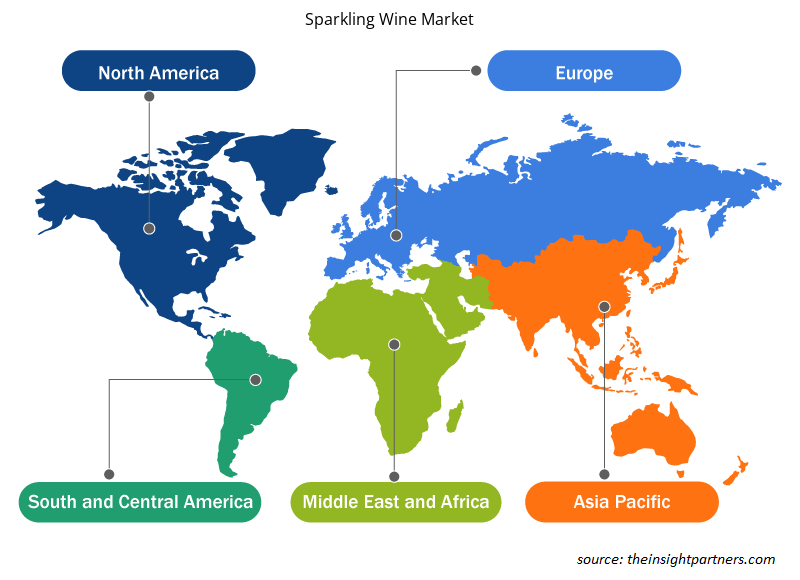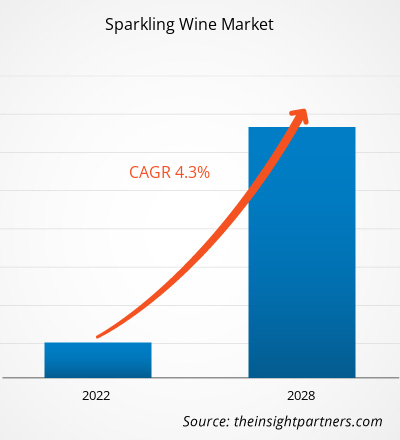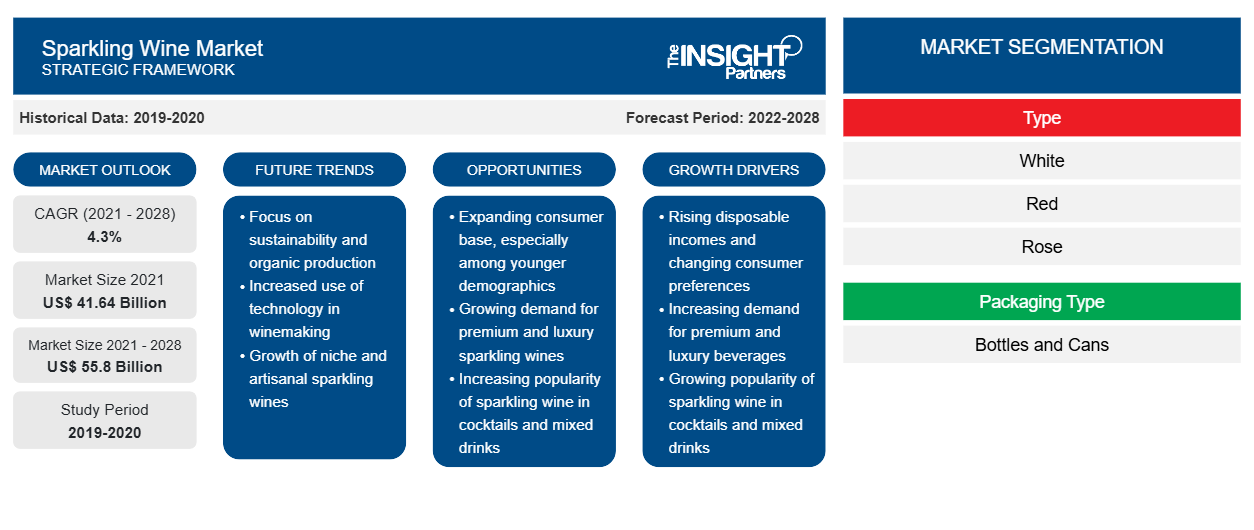Il mercato dei vini spumanti è stato valutato 41,64 miliardi di dollari nel 2021 e si prevede che raggiungerà i 55,80 miliardi di dollari entro il 2028; si prevede una crescita a un CAGR del 4,3% dal 2021 al 2028.
Lo spumante è una variante del vino con un alto contenuto di anidride carbonica, che gli conferisce ulteriore bollicina. Lo champagne è uno dei tipi di spumante più popolari. È il vino prodotto nella regione francese dello Champagne; tuttavia, molti produttori di spumante negli Stati Uniti usano questo nome per i loro prodotti locali.
Nel 2020, l'Europa ha rappresentato la quota maggiore del mercato dello spumante . L'Unione Europea (UE) ha la più grande concentrazione di produttori di spumante. Secondo l'Institute of Wine and Vine, l'UE rappresenta il 70-80% della quota, in volume, della produzione globale di spumante dal 2000. Secondo gli esperti del settore, l'Europa esporta un volume maggiore di spumante rispetto al vino fermo nei mercati internazionali. La regione ha una lunga e illustre storia di vinificazione. Gli amanti del vino in tutto il mondo preferiscono lo spumante europeo per i suoi sapori, gusti e metodi di preparazione unici. Inoltre, la crescente preferenza per bevande meno alcoliche, la crescente influenza delle celebrità sullo stile di vita delle persone, l'inclinazione verso cibi e bevande pronti e la tradizione di stappare una bottiglia di Champagne o spumante durante feste e celebrazioni, tra gli altri, giustificano il drammatico aumento della domanda per questa categoria di vino. L'Europa ha un mercato dello spumante altamente consolidato, che è composto da diversi distillatori importanti e piccoli.
I produttori di vini spumanti sono stati notevolmente colpiti dalla scarsa disponibilità di lavoratori durante la pandemia di COVID-19, che ha ostacolato la loro capacità produttiva. Inoltre, la chiusura dei mercati all'ingrosso ha costretto i produttori ad affidarsi principalmente a supermercati e rivenditori di e-commerce per vendere i loro prodotti di vini spumanti. Nonostante la pandemia, si è registrato un aumento delle vendite di vino rosato e spumante.
Personalizza questo report in base alle tue esigenze
Riceverai la personalizzazione gratuita di qualsiasi report, comprese parti di questo report, o analisi a livello nazionale, pacchetto dati Excel, oltre a usufruire di grandi offerte e sconti per start-up e università
-
Scopri le principali tendenze di mercato in questo rapporto.Questo campione GRATUITO includerà analisi di dati che spaziano dalle tendenze di mercato alle stime e alle previsioni.
Approfondimenti di mercato
Aumento della popolarità del vino spumante
I rapidi cambiamenti socioeconomici e l'urbanizzazione frenetica stanno rafforzando la domanda di vino spumante. Con il continuo aumento degli standard di vita e del potere d'acquisto, i clienti desiderano acquistare articoli di lusso e di alta qualità. Inoltre, le loro abitudini alimentari e le loro preferenze per i pasti cambiano con questi cambiamenti nello stile di vita. Pertanto, la domanda di vino spumante per feste, matrimoni e incontri sociali è in aumento. Con la crescente preferenza per bevande con basso o nullo contenuto di alcol, la popolarità di questo vino sta aumentando tra i millennial, gli adolescenti e la popolazione attiva, nonché tra gli scapoli e le persone che vivono in ostelli. Inoltre, l'uso diffuso dei social media e di Internet sta influenzando in modo significativo tutte le generazioni, mentre l'aumento del numero di feste ed eventi sociali sta contribuendo all'aumento del consumo di vino spumante a livello globale, principalmente nelle nazioni sviluppate come Stati Uniti, Canada, Messico, Germania, Francia e Italia, guidando così la crescita del mercato del vino spumante.millennials, teenagers, and working populations, and in bachelors and people living in hostels. Furthermore, the widespread use of social media and the Internet is significantly impacting all generations, while rise in number of parties and social events are contributing to the rise in consumption of sparkling wine globally, primarily in developed nations such as the US, Canada, Mexico, Germany, France, and Italy, thereby driving the sparkling wine market growth.
Tipo Informazioni
In base al tipo, il mercato dei vini spumanti è suddiviso in rosso, bianco e rosato. Nel 2020, il segmento bianco ha rappresentato la quota di mercato maggiore. Il vino bianco è prodotto con uve Moscato Bianco provenienti dalla regione vinicola piemontese. La sua produzione è concentrata principalmente ad Alba e nella provincia di Asti, nel nord Italia. Le bollicine sono causate dalla fermentazione naturale, che può avvenire in bottiglia o in un grande serbatoio. La fermentazione avviene quando lo zucchero viene aggiunto al vino e il lievito agisce sullo zucchero, generando anidride carbonica. Le bollicine si formano nel vino a causa dell'anidride carbonica intrappolata all'interno di un ambiente chiuso.Moscato Bianco grapes from Italy’s Piedmont wine region. Its production is primarily concentrated in Alba and the province of Asti in Northern Italy. The bubbles are caused by natural fermentation, which might occur in the bottle or a big tank. Fermentation occurs when sugar is added to wine and yeast acts on the sugar, generating carbon dioxide. Bubbles are formed in the wine as a result of the trapped carbon dioxide inside an enclosed environment.
Bacardi & Company Limited; Bronco Wine Co.; Casella; Constellation Brands, Inc.; Henkell Freixenet; Chandon; Schramsberg Wineyards; Pernod Ricard Winemakers; The Sparkling Wine Co.; Treasury Wine Estates Ltd; Bottega Spa; Campari Group; e Codorniu sono tra i principali attori del mercato dei vini spumanti.Casella; Constellation Brands, Inc.; Henkell Freixenet; Chandon; Schramsberg Wineyards; Pernod Ricard Winemakers; The Sparkling Wine Co.; Treasury Wine Estates Ltd; Bottega Spa; Campari Group; and Codorniu are among the key players in the sparkling wine market.
Approfondimenti regionali sul mercato dei vini spumanti
Le tendenze regionali e i fattori che influenzano il mercato dei vini spumanti durante il periodo di previsione sono stati ampiamente spiegati dagli analisti di Insight Partners. Questa sezione discute anche i segmenti e la geografia del mercato dei vini spumanti in Nord America, Europa, Asia Pacifico, Medio Oriente e Africa, e Sud e Centro America.

- Ottieni i dati specifici regionali per il mercato del vino spumante
Ambito del rapporto sul mercato del vino spumante
| Attributo del report | Dettagli |
|---|---|
| Dimensioni del mercato nel 2021 | 41,64 miliardi di dollari USA |
| Dimensioni del mercato entro il 2028 | 55,8 miliardi di dollari USA |
| CAGR globale (2021 - 2028) | 4,3% |
| Dati storici | 2019-2020 |
| Periodo di previsione | 2022-2028 |
| Segmenti coperti |
Per tipo
|
| Regioni e Paesi coperti |
America del Nord
|
| Leader di mercato e profili aziendali chiave |
|
Densità degli attori del mercato del vino spumante: comprendere il suo impatto sulle dinamiche aziendali
Il mercato del vino spumante sta crescendo rapidamente, spinto dalla crescente domanda degli utenti finali dovuta a fattori quali l'evoluzione delle preferenze dei consumatori, i progressi tecnologici e una maggiore consapevolezza dei benefici del prodotto. Con l'aumento della domanda, le aziende stanno ampliando le loro offerte, innovando per soddisfare le esigenze dei consumatori e capitalizzando sulle tendenze emergenti, il che alimenta ulteriormente la crescita del mercato.
La densità degli operatori di mercato si riferisce alla distribuzione di aziende o società che operano in un particolare mercato o settore. Indica quanti concorrenti (operatori di mercato) sono presenti in un dato spazio di mercato in relazione alle sue dimensioni o al valore di mercato totale.
Le principali aziende che operano nel mercato dei vini spumanti sono:
- Bacardi e società a responsabilità limitata
- Azienda vinicola Bronco.
- Casella
- Marchio della costellazione, Inc.
- Henkell Freixenet
Disclaimer : le aziende elencate sopra non sono classificate secondo un ordine particolare.

- Ottieni una panoramica dei principali attori del mercato dei vini spumanti
Segnala i riflettori
- Tendenze progressive del settore nel mercato globale dello spumante per aiutare gli operatori a sviluppare strategie efficaci a lungo termine
- Strategie di crescita aziendale adottate dalle aziende nei mercati sviluppati e in via di sviluppo
- Analisi quantitativa del mercato globale dello spumante dal 2019 al 2028
- Stima della domanda di vino spumante da parte dei consumatori
- Analisi PEST per illustrare l'efficacia degli acquirenti e dei fornitori che operano nel settore per prevedere la crescita del mercato
- Sviluppi recenti per comprendere lo scenario competitivo del mercato e la domanda di vino spumante
- Tendenze e prospettive del mercato, insieme ai fattori che guidano e frenano la crescita del mercato dello spumante
- Comprensione delle strategie che sostengono l'interesse commerciale nel mercato, assistendo così nel processo decisionale per gli operatori del mercato
- Dimensioni del mercato del vino spumante nei vari nodi del mercato
- Panoramica dettagliata e segmentazione del mercato globale dello spumante, nonché delle sue dinamiche di settore
- Dimensioni del mercato del vino spumante in diverse regioni con promettenti opportunità di crescita
Mercato del vino spumante, per tipo
- Bianco
- Rosso
- Rosa
Mercato del vino spumante, per tipo di imballaggio
- Bottiglie
- Lattine
Mercato del vino spumante, per canale di distribuzione
- Supermercati e Ipermercati
- Negozi specializzati
- Vendita al dettaglio online
- Altri
Profili aziendali
- Bacardi e società a responsabilità limitata
- Azienda vinicola Bronco.
- Casella
- Marchio della costellazione, Inc.
- Henkell Freixenet
- Vigneti Schramsberg
- Produttori di vino Pernod Ricard
- La società produttrice di vini spumanti
- Azienda vinicola Treasury
- Candon-Can ...
- Analisi storica (2 anni), anno base, previsione (7 anni) con CAGR
- Analisi PEST e SWOT
- Valore/volume delle dimensioni del mercato - Globale, Regionale, Nazionale
- Industria e panorama competitivo
- Set di dati Excel
Report recenti
Rapporti correlati
Testimonianze
Motivo dell'acquisto
- Processo decisionale informato
- Comprensione delle dinamiche di mercato
- Analisi competitiva
- Analisi dei clienti
- Previsioni di mercato
- Mitigazione del rischio
- Pianificazione strategica
- Giustificazione degli investimenti
- Identificazione dei mercati emergenti
- Miglioramento delle strategie di marketing
- Aumento dell'efficienza operativa
- Allineamento alle tendenze normative























 Ottieni un campione gratuito per - Mercato del vino spumante
Ottieni un campione gratuito per - Mercato del vino spumante